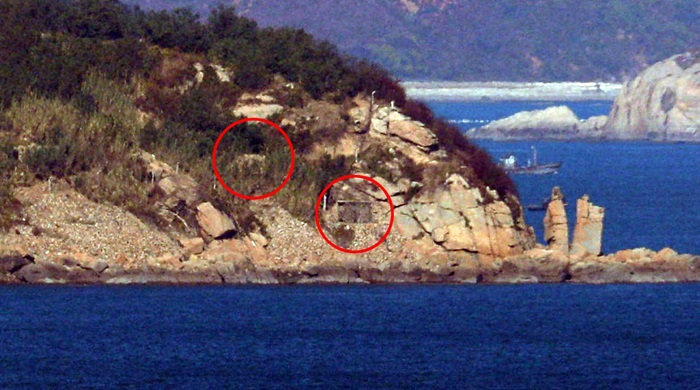Koreas act to remove threat of war on peninsula

South and North Korea will stop all hostile military acts against each other on land, sea and air under their Sept. 19 military agreement. On Nov. 1, North Korea’s coastline artillery is seen covered and closed on the Yellow Sea border island of Jangjaedo in the North. The photo was taken from the Manghyang Observatory of Yeonpyeongdo Island in the South. (Yonhap News)
By Kim Young Deok, Yoon Sojung and Kim Young Shin
South and North Korea on Nov. 1 ceased all hostile acts against each other on land, sea and air following their bilateral military agreement signed on Sept. 19.
This is considered a milestone in removing the threat of war on the Korean Peninsula.
The South Korean Ministry of National Defense on Oct. 31 said the military authorities of both Koreas stopped all live-fire artillery drills and regiment-level field maneuvers from midnight, Nov. 1, 2018, under the inter-Korean military agreement.
The ministry added that the two sides stopped firing from warships and naval maneuvers within the buffer zones of the East and Yellow seas. The ministry also said they closed the artillery gun holes of warships and closed coastline artillery installations on border islands such as Yeonpyeongdo and Baengnyeongdo.
On airspace restrictions, the two sides officially proclaimed a no-fly zone for each aircraft type and adjusted the location of the airspace used for a joint drill between South Korean and U.S. air forces.
The North officially announced that it will implement measures to halt all hostile military acts per the Agreement on the Implementation of the Historic Panmunjeom Declaration in the Military Domain, such as closing gun ports along the western sea boundary.
The Ministry of National Defense in Seoul said the United Nations Command expressed support for the steps taken to halt all hostile acts on land, sea and air between the Koreas.
The ministry added that the decision will accelerate the easing of military tension and building trust between South and North Korea, calling the measures “meaningful steps” to advance the denuclearization of the Korean Peninsula and setting up a permanent peace in the region.
***


